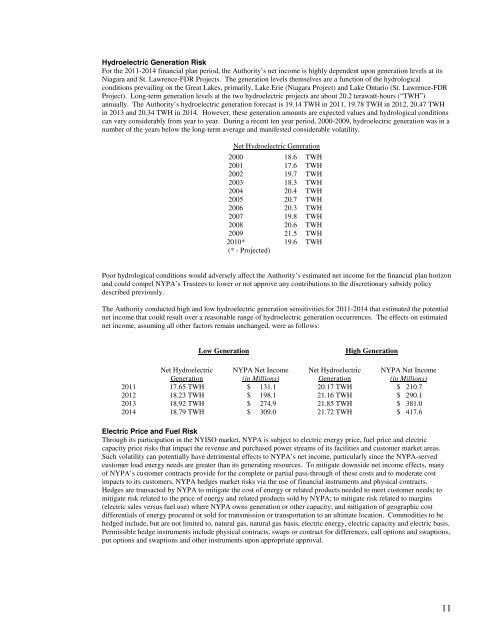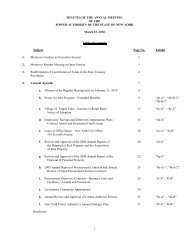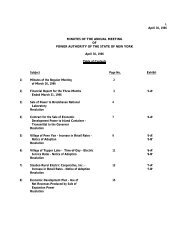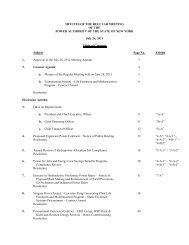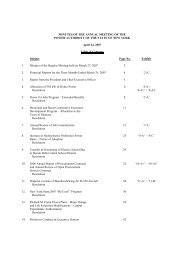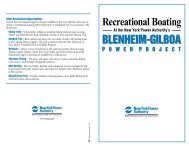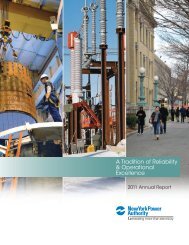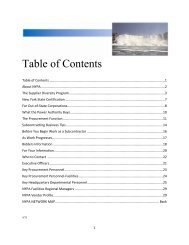PDF - New York Power Authority
PDF - New York Power Authority
PDF - New York Power Authority
Create successful ePaper yourself
Turn your PDF publications into a flip-book with our unique Google optimized e-Paper software.
Hydroelectric Generation Risk<br />
For the 2011-2014 financial plan period, the <strong>Authority</strong>’s net income is highly dependent upon generation levels at its<br />
Niagara and St. Lawrence-FDR Projects. The generation levels themselves are a function of the hydrological<br />
conditions prevailing on the Great Lakes, primarily, Lake Erie (Niagara Project) and Lake Ontario (St. Lawrence-FDR<br />
Project). Long-term generation levels at the two hydroelectric projects are about 20.2 terawatt-hours (“TWH”)<br />
annually. The <strong>Authority</strong>’s hydroelectric generation forecast is 19.14 TWH in 2011, 19.78 TWH in 2012, 20.47 TWH<br />
in 2013 and 20.34 TWH in 2014. However, these generation amounts are expected values and hydrological conditions<br />
can vary considerably from year to year. During a recent ten year period, 2000-2009, hydroelectric generation was in a<br />
number of the years below the long-term average and manifested considerable volatility.<br />
Net Hydroelectric Generation<br />
2000 18.6 TWH<br />
2001 17.6 TWH<br />
2002 19.7 TWH<br />
2003 18.3 TWH<br />
2004 20.4 TWH<br />
2005 20.7 TWH<br />
2006 20.3 TWH<br />
2007 19.8 TWH<br />
2008 20.6 TWH<br />
2009 21.5 TWH<br />
2010* 19.6 TWH<br />
(* - Projected)<br />
Poor hydrological conditions would adversely affect the <strong>Authority</strong>’s estimated net income for the financial plan horizon<br />
and could compel NYPA’s Trustees to lower or not approve any contributions to the discretionary subsidy policy<br />
described previously.<br />
The <strong>Authority</strong> conducted high and low hydroelectric generation sensitivities for 2011-2014 that estimated the potential<br />
net income that could result over a reasonable range of hydroelectric generation occurrences. The effects on estimated<br />
net income, assuming all other factors remain unchanged, were as follows:<br />
Low Generation<br />
High Generation<br />
Net Hydroelectric<br />
Generation<br />
NYPA Net Income<br />
(in Millions)<br />
Net Hydroelectric<br />
Generation<br />
NYPA Net Income<br />
(in Millions)<br />
2011 17.65 TWH $ 131.1 20.17 TWH $ 210.7<br />
2012 18.23 TWH $ 198.1 21.16 TWH $ 290.1<br />
2013 18.92 TWH $ 274.9 21.85 TWH $ 381.0<br />
2014 18.79 TWH $ 309.0 21.72 TWH $ 417.6<br />
Electric Price and Fuel Risk<br />
Through its participation in the NYISO market, NYPA is subject to electric energy price, fuel price and electric<br />
capacity price risks that impact the revenue and purchased power streams of its facilities and customer market areas.<br />
Such volatility can potentially have detrimental effects to NYPA’s net income, particularly since the NYPA-served<br />
customer load energy needs are greater than its generating resources. To mitigate downside net income effects, many<br />
of NYPA’s customer contracts provide for the complete or partial pass-through of these costs and to moderate cost<br />
impacts to its customers, NYPA hedges market risks via the use of financial instruments and physical contracts.<br />
Hedges are transacted by NYPA to mitigate the cost of energy or related products needed to meet customer needs; to<br />
mitigate risk related to the price of energy and related products sold by NYPA; to mitigate risk related to margins<br />
(electric sales versus fuel use) where NYPA owns generation or other capacity; and mitigation of geographic cost<br />
differentials of energy procured or sold for transmission or transportation to an ultimate location. Commodities to be<br />
hedged include, but are not limited to, natural gas, natural gas basis, electric energy, electric capacity and electric basis.<br />
Permissible hedge instruments include physical contracts, swaps or contract for differences, call options and swaptions,<br />
put options and swaptions and other instruments upon appropriate approval.<br />
11


